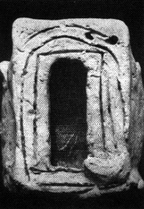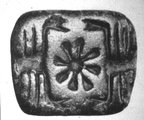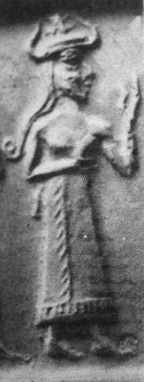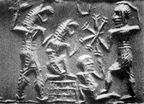
Goddess from the Other World
2000-1600 B.C. Isin-Larsa-Old Babylonian period.
Hematite. Cylinder seal.
Mesopotamia
An enormous winged bird-footed goddess stands frontally with hands clasped. A double register scene appears alongside her. In the upper register a nude goddess and a bearded deity receive homage from human worshippers. A row of composite beings appear in the lower register. A fly, a hedgehog(?), and a human head appear above these creatures in the field.
This goddess with bird features has been identified with Lilith. She may represent the chthonic aspect of Inanna/Ishtar derived from her association with the demonic and frequently bird-like creatures and gods that inhabit the underworld. Here, the goddessšs horned head appears alongside deities and their human worshippers while her bird-feet appear beside demonic creatures. The hierarchical arrangement of this scene may signify her dual nature, partially of "heaven and earth" and partially of the underworld.

Inanna on Her Throne
c.2000-1600 B.C. Akkad period.
Nephrite. Cylinder seal.
Mesopotamia
During the period of Akkadian control of Mesopotamia (c.2334-2154 B.C.), the early Sumerian "Lady of Heaven" and fertility goddess Inanna merged with the Semitic Ishtar, a warrior goddess. The goddess Inanna/Ishtar appears on this Akkadian seal, seated on a throne decorated with two crossed lions. Weapons, including a scimitar and a mace, rise from her shoulders as she gestures to two worshippers and looks full-face at the viewer. Her flounced garment covers only one shoulder, and her long hair falls in curls down to her elbows. To the left of Inanna/Ishtar stands an attendant goddess wearing a single-horned miter. To her right a female figure gestures in worship and pours a libation into a vessel.

Door to the Underworld
2000-1600 B.C. Isin-Larsa-Old Babylonian period.
Baked clay.
Mesopotamia
An open door leads into the interior of a rectangular terracotta box that probably represents a shrine. Inside sits a bird-beaked figure, wearing the long flounced robe characteristic of divinities.

Goddess in Underworld
c.2330-2150 B.C. Akkad period.
Hematite. Cylinder seal.
Mesopotamia
Flanked by two forms shaped like mountains, perhaps symbolic of the kur (the underworld), stands a frontal-facing goddess. Undulating rays or flames rise from her shoulders and may indicate either her solar or infernal nature. A ring -- possibly similar to the ring that was taken from Inanna when she entered the fifth gate of the underworld -- is held in her hand.
To the right, within one mountain, a deity with rays or flames rising from his shoulders grasps the tail of a bull-man. To the left, a deity with a scourge stands grasping the horn of another deity who collapses within another flaming mountain. A small figure kneels beside the mountain to the left.

Scorpions and Rosette
c.3300 B.C. Gawra period.
Steatite. Stamp seal.
North Mesopotamia
Inannašs symbol, the eight-pointed star or rosette, appears between the pincers of two scorpions on the square face of this stamp seal.

Goddess Entreating (detail)
c.2330-2150 B.C. Akkad period.
Marble. Cylinder seal.
Mesopotamia
Many Mesopotamian prayers had to be spoken out loud and accompanied by specific gestures. According to Leo Oppenheim, the best attested of these prayers is the type named su-ila, or "uplifted hands."
On this seal, a goddess stands with an uplifted hand, perhaps performing a similar prayer-like ritual. Uplifted hands are characteristic of goddesses in Mesopotamian art, especially during the Neo-Sumerian and Old Babylonian period, c.2100-1600, B.C. Such goddesses have been identified as lama, female protective beings that Oppenheim calls "angels." These goddesses served as supplicants on behalf of human worshippers, offering prayers for their well-being.

Goddess Pleading Before Enki
c.2330-2150 B.C. Akkad period.
Marble. Cylinder seal.
Mesopotamia
A supplicating goddess of lower rank, indicated by her single-horned miter, approaches the enthroned Enki flanked by his two-faced minister Isimud and his acolyte, the nude hero. With her arm uplifted and her hand held before her mouth, she appears as a supplicant to Enki.

Attacking Demons
c.2000-1600 B.C. Isin-Larsa-Old Babylonian period.
Hematite. Cylinder seal.
Ischali, in the Diyala region, Mesopotamia.
A kneeling figure with upraised arm is attacked by demonic creatures with leonine heads and bird feet, and by a male figure with multiple mace and scimitar.
The exact nature of the demonic figures is difficult to determine, but the association of birdlike beings with the nether world is common in the Near East and the Aegean. The galla are described as those "who flutter over heaven and earth" in "Dumuzišs Dream", suggesting their birdlike nature. And as Henri Frankfort has shown, soul-birds in Egypt and harpies and sirens in the Aegean area all objectified certain aspects of terror inspired by death. The frightening, bird-clawed monsters with gaping mouths may represent similar underworld beings threatening the small cringing man with death.

Cattle Byres
c.3200-3000 B.C. Late Uruk-Jemdet Nasr period.
Magnesite. Cylinder seal.
In the lower field of this seal appear three reed cattle byres. Each byre is surmounted by three reed pillars topped by rings, a motif that has been suggested as symbolizing a male god, perhaps Dumuzi. Within the huts calves or vessels appear alternately; from the sides come calves that drink out of a vessel between them. Above each pair of animals another small calf appears. A herd of enormous cattle moves in the upper field.

Leaping Stag
c.1300-1200 B.C. Middle Assyrian period.
Milky chalcedony. Cylinder seal.
A stag leaps with upflung leg through a wooded, mountainous region, indicated by the twisted trees and scale pattern representing the mountain from which it grows. A small bird is perched on a thistle-like plant beneath the tree.

King Feeding Rosette Flowers to Sheep
c.3200-3000 B.C. Late Uruk-Jemdet Nasr period.
Marble. Cylinder seal.
Mesopotamia
A bearded male figure wears a round cap and a skirt with netlike pattern. This man appears on many artifacts excavated at Inannašs city, Uruk, and may represent the en, or priest-king, of the city, who assumes the role of divine consort of Inanna in the sacred marriage ceremony. Clasped to his chest are two curving branches ending in rosette-flowers. These rosette symbols of Inanna are nibbled by maned sheep, literally portraying the nourishment of the flocks ensured by the union of the goddess and her consort. The emblems of Inanna that flank the scene suggest that it is taking place within the sacred precinct of her temple.

Dying Man
9th century B.C. Neo-Assyrian period.
Serpentine. Cylinder seal.
Mesopotamia
A sick or dying man lies beneath a reed hut. Attendant figures, perhaps exorcist priests, lean above him and kneel at the head of his bed. Sacred dogs of Gula, the Goddess of Healing, leap about the exterior of the hut.

The Feather of Maat. Funerary Papyrus of Ani.
1306-1186 B.C. 19th dynasty.
Papyrus
London, British Museum

Feather of Maat. Funerary Papyrus of Hunefer.
1306-1186 B.C. 19th dynasty.
Papyrus
London, British Museum